10 0 0 0 IR 文学教育のための物語論
- 著者
- 濵田 秀行 HAMADA Hideyuki ハマダ ヒデユキ
- 出版者
- 群馬大学教育学部
- 雑誌
- 群馬大学教育学部紀要. 人文・社会科学編 (ISSN:03864294)
- 巻号頁・発行日
- vol.66, pp.37-49, 2017
6 0 0 0 OA 隠された友情 -『ゲッティンゲン書評』をめぐるカント-ガルヴェ往復書簡について-
- 著者
- 小谷 英生 コタニ ヒデオ Kotani Hideo
- 出版者
- 群馬大学教育学部
- 巻号頁・発行日
- vol.63, pp.55-68, 2014-02-10
4 0 0 0 IR 日本語史における平成時代の音韻変化
- 著者
- 柴田 知薫子 SHIBATA Chikako
- 出版者
- 群馬大学教育学部
- 雑誌
- 群馬大学教育学部紀要. 人文・社会科学編 = Annual reports of the Faculty of Education, Gunma University. Cultural science series (ISSN:03864294)
- 巻号頁・発行日
- vol.69, pp.101-109, 2020
Phonological system of a particular language could change in thirty years of one generation. The Japanese language has undergone phonological evolution of its consonant system and prosodic system in these thirty years of the Heisei period: the distinctive feature of voiced plosives has changed from voicing to tenseness; the prosodic unit is changing from mora to syllable; the culminative function has predominated the distinctive function of word accent. These phonological changes are reflected on several cases of phonetic change among Japanese speakers of the Heisei generation.
4 0 0 0 IR 隠された友情 : 『ゲッティンゲン書評』をめぐるカント‐ガルヴェ往復書簡について
- 著者
- 小谷 英生 コタニ ヒデオ Kotani Hideo
- 出版者
- 群馬大学教育学部
- 雑誌
- 群馬大学教育学部紀要. 人文・社会科学編 (ISSN:03864294)
- 巻号頁・発行日
- vol.63, pp.55-68, 2014
3 0 0 0 IR 郷土かるた、上毛かるたの魅力と意義--郷土かるた王国「群馬」からの発信
- 著者
- 原口 美貴子 山口 幸男
- 出版者
- 群馬大学教育学部
- 雑誌
- 群馬大学教育学部紀要 人文・社会科学編 (ISSN:03864294)
- 巻号頁・発行日
- vol.59, pp.9-20, 2010
2 0 0 0 IR 差別化としての「和歌嫌い」 ── 『枕草子』における行成の人物像の特色 ──
- 著者
- 藤本 宗利 FUJIMOTO Munetoshi フジモト ムネトシ
- 出版者
- 群馬大学教育学部
- 雑誌
- 群馬大学教育学部紀要. 人文・社会科学編 (ISSN:03864294)
- 巻号頁・発行日
- vol.67, pp.1-15, 2018-01-31
2 0 0 0 IR 連歌を挑む後宮 ── 『枕草子』「細殿にびんなき人なむ」の段を中心に ──
- 著者
- 藤本 宗利 FUJIMOTO Munetoshi
- 出版者
- 群馬大学教育学部
- 雑誌
- 群馬大学教育学部紀要. 人文・社会科学編 (ISSN:03864294)
- 巻号頁・発行日
- no.69, pp.1-16, 2020-01-31
1 0 0 0 OA 長方形の面積の公式における「縦×横」の変遷と多様性について
- 著者
- 伊藤 隆
- 出版者
- 群馬大学教育学部
- 雑誌
- 群馬大学教育学部紀要. 自然科学編 (ISSN:10004800)
- 巻号頁・発行日
- vol.57, pp.5-14, 2009-02-17
1 0 0 0 OA パーソナリティ研究と神経科学をつなぐ気質研究について
- 著者
- 国里 愛彦 山口 陽弘 鈴木 伸一
- 出版者
- 群馬大学教育学部
- 雑誌
- 群馬大学教育学部紀要. 人文・社会科学編 (ISSN:03864294)
- 巻号頁・発行日
- vol.56, pp.359-378, 2007-02-14
1 0 0 0 IR 嬬恋村鎌原における天明三年(1783年)浅間山噴火流死者供養の成立と変遷
- 著者
- 井上 雄斗 早川 由紀夫 早川 由紀夫 HAYAKAWA Yukio
- 出版者
- 群馬大学教育学部
- 雑誌
- 群馬大学教育学部紀要. 自然科学編 = Science reports of the Faculty of Education, Gunma University (ISSN:00175668)
- 巻号頁・発行日
- vol.67, pp.21-37, 2019
1 0 0 0 IR 榛名山で古墳時代に起こった渋川噴火の理学的年代決定
- 著者
- 早川 由紀夫 中村 賢太郎 藤根 久 中村 賢太郎 ナカムラ ケンタロウ Nakamura Kentaro 藤根 久 フジネ ヒサシ Fujine Hisashi 伊藤 茂 イトウ シゲル Ito Shigeru 廣田 正史 ヒロタ マサシ Hirota Masashi 小林 紘一 コバヤシ コウイチ Kobayashi Koichi
- 出版者
- 群馬大学教育学部
- 雑誌
- 群馬大学教育学部紀要. 自然科学編 = Science reports of the Faculty of Education, Gunma University (ISSN:00175668)
- 巻号頁・発行日
- vol.63, pp.35-39, 2015
Radiocarbon wiggle matching method was applied for precise dating of a tephra which was designated asone of the important key beds for archaeology. The FA tephra is a pyroclastic deposit from the Shibukawaeruption of Haruna Volcano during the Kofun period of Japan. The age of FA has been investigated usingarchaeological remains and also historical records of Japan and China. It has been estimated roughly as early6th century. Three tumbled logs were found being buried in the tephra whose thickness was about 4 m. Thelogs were cut in many groups with five tree rings and every two groups were sampled for C measurement. Asthese trees were thought to have the same age from the occurrence,all data were used for wiggle matchinganalysis. The age of the outermost tree ring group is determined as AD 491-500(AD 497/+3/-6).
1 0 0 0 IR 福島第一原発2011年3月事故による放射能汚染と健康リスク評価
- 著者
- 早川 由紀夫 ハヤカワ ユキオ Hayakawa Yukio
- 出版者
- 群馬大学教育学部
- 雑誌
- 群馬大学教育学部紀要. 自然科学編 = Science reports of the Faculty of Education, Gunma University (ISSN:00175668)
- 巻号頁・発行日
- vol.62, pp.35-50, 2014
2011年3月11日に起こった大きな地震と津波のあとしばらくして、大量の放射性物質が福島第一原発から大気中に出た。私はその汚染分布を迅速に把握して地図に表現し、インターネットで即座に公表した。放射性物質は原発から連続的定常的に放出されたのではなかった。3月12日、3月15日、それから3月20-21日に大きな放出イベントがあった。原子炉格納容器の圧力が低下あるいは上昇したときに対応する。順に1号機、2号機、3号機からの放出だった。大気中に出たセシウムは1京1000兆ベクレル(11PBq)。1986年のチェルノブイリ原発事故で出たセシウムの1/12である。しかし人口密度を考慮すると、被害は両者ほぼ同じかフクシマが3倍深刻である。芝生や森の林床だけでなく、アスファルトの上でも2011年3月に降り積もったセシウムはほとんど移動していない。そういった場所の放射線量率の自然減衰はセシウム134と137の半減期でよく説明できる。この事故で放出されたセシウムに起因するがん死の増加は5300人と見積もられる。今後50年間の福島中通りにおける放射能リスクは交通事故リスクの1/2である。
1 0 0 0 IR 日本火山のリスク評価
- 著者
- 早川 由紀夫 Hayakawa Yukio ハヤカワ ユキオ
- 出版者
- 群馬大学教育学部
- 雑誌
- 群馬大学教育学部紀要. 自然科学編 = Science reports of the Faculty of Education, Gunma University (ISSN:00175668)
- 巻号頁・発行日
- vol.64, pp.49-55, 2016
1 0 0 0 IR フィクションにおけるリアリティ : 小説、枠組み、読み
- 著者
- 金田 仁秀 KANEDA Masahide カネダ マサヒデ
- 出版者
- 群馬大学教育学部
- 雑誌
- 群馬大学教育学部紀要. 人文・社会科学編 = Annual reports of the Faculty of Education, Gunma University. Cultural science series (ISSN:03864294)
- 巻号頁・発行日
- vol.67, pp.149-163, 2018
1 0 0 0 IR ジェンダーに敏感な視点に立った小学校社会科授業構築の試み
- 著者
- 関 友里 斎藤 周 斎藤 周 SAITO Madoka
- 出版者
- 群馬大学教育学部
- 雑誌
- 群馬大学教育学部紀要. 人文・社会科学編 = Annual reports of the Faculty of Education, Gunma University (ISSN:03864294)
- 巻号頁・発行日
- vol.68, pp.51-68, 2019
1 0 0 0 IR 「教科化」は道徳教育を改善するか
- 著者
- 山崎 雄介 ヤマザキ ユウスケ Yamazaki Yusuke
- 出版者
- 群馬大学教育学部
- 雑誌
- 群馬大学教育学部紀要. 人文・社会科学編 (ISSN:03864294)
- 巻号頁・発行日
- vol.64, pp.157-171, 2015
1 0 0 0 IR 思い出の中の教師--自伝的記憶の機能分析
- 著者
- 佐藤 浩一
- 出版者
- 群馬大学教育学部
- 雑誌
- 群馬大学教育学部紀要 人文・社会科学編 (ISSN:03864294)
- 巻号頁・発行日
- no.49, pp.357-378, 2000
- 被引用文献数
- 1
- 著者
- 西田 直嗣 鈴木 晶子
- 出版者
- 群馬大学教育学部
- 雑誌
- 群馬大学教育学部紀要. 芸術・技術・体育・生活科学編 (ISSN:05336627)
- 巻号頁・発行日
- vol.47, pp.17-25, 2012
1 0 0 0 那須国造碑の研究
- 著者
- 森田 悌 田村 充
- 出版者
- 群馬大学教育学部
- 雑誌
- 群馬大学教育学部紀要 人文・社会科学編 (ISSN:03864294)
- 巻号頁・発行日
- vol.54, pp.1-11, 2005
1 0 0 0 IR 陸上短距離走におけるスタートダッシュとSSC運動能力との関連
- 著者
- 中雄 勇人 間中 葵 斎藤 慶子 間中 葵 Manaka Aoi 斎藤 慶子 Saito Keiko サイトウ ケイコ 田島 昌紘 Tajima Masahiro タジマ マサヒロ 須田 光 Suda Hikaru スダ ヒカル 石田 真規 Ishida Masaki イシダ マサキ
- 出版者
- 群馬大学教育学部
- 雑誌
- 群馬大学教育学部紀要. 芸術・技術・体育・生活科学編 (ISSN:05336627)
- 巻号頁・発行日
- vol.51, pp.77-82, 2016
